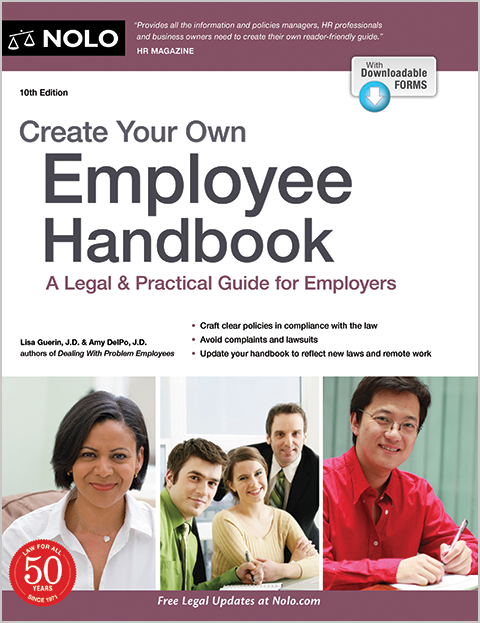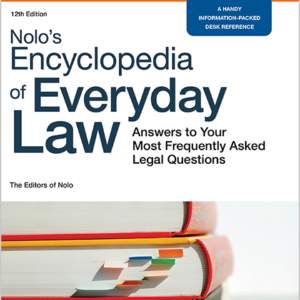What an Employee Handbook Can Do for Your Organization
If you’re like most managers, you (or people who work for you) probably devote a good part of every day to employee relations. If you’re in human resources or own a business, you may find yourself making decisions or fielding questions about everything from benefits to vacation time to disciplinary problems. Sometimes, you may know the answer right away (“You get ten vacation days”); other times, you may have to think a bit or come up with something new (“What is our policy on paternity leave?”).
In such situations, a good employee handbook is essential. An employee handbook is a written and/or electronic document describing the benefits and responsibilities of the employment relationship. In reality, however, the handbook’s role is much more complex and powerful. While it sits quietly on the shelf (or server), the employee handbook can actually help define and manage your company’s relationship with its employees. It knows all the answers and communicates them clearly to employees. Indeed, an employee handbook can do a lot for your company, including:
- save time by cutting down on the number of questions employees ask every day
- ensure that the company treats employees consistently, and
- provide legal protection when an employment relationship goes sour.
The Purposes of an Employee Handbook
An employee handbook is an indispensable workplace tool that helps your company communicate with employees, manage its workers (and managers), streamline its organization, and protect itself from lawsuits.
Communication
A handbook tells employees what the company expects from them and what they can expect from the company. “What time do I have to be at work?” “Does my employer provide health insurance?” “How do I complain about my supervisor’s sexual advances?” A well-drafted handbook will answer all of these questions and many more.
In addition to relaying basic information about benefits, hours, and pay, an employee handbook imparts the company’s culture, values, and history. When was the company founded? Why is it successful? What attitude should employees take toward their jobs and customers? This information can help motivate employees to work more effectively and enthusiastically on behalf of the company.
Management
Employees are not mind readers. Although you may know what the company’s practices and policies are, without a handbook, other employees, managers, and supervisors have no place to turn for this information. This creates an environment ripe for trouble, both legal and practical. Employee morale will drop if employees are treated inconsistently, possibly resulting in a discrimination lawsuit if an employee thinks this different treatment is based on race, gender, or some other protected characteristic.
Handbooks promote positive employee relations by ensuring that all employees are treated consistently and fairly. They prevent misunderstandings, confusion, and complaints by giving everyone the same resource for learning company personnel practices. If there is ever any doubt or dispute about a particular policy, you can simply open the book and take a look. You don’t need to have long, agonizing discussions or try to reinvent the wheel.
Planning
The process of creating (or reviewing) a handbook will force your company’s management to carefully consider every aspect of its relationship with employees. Rather than doing things a certain way just because that’s the way they’ve always been done, you can reflect on how employees have been treated and consider whether any changes are in order. For each policy, your company’s decision makers should ask themselves: Do we really want to continue doing things this way? Why or why not?
Creating an employee handbook necessarily requires communication with, and feedback from, employees, supervisors, and managers about the company’s current personnel practices. This will help determine what works and what doesn’t, what should change and what should stay the same, and what new policies or practices the company might want to adopt.
Legal Protection
Just having a handbook can help your company comply with the law and reduce its risk of lawsuits. Consider the following:
- Some laws require employers to communicate certain information to their employees. The handbook provides a convenient place to put this information.
- Even when the company isn’t required to give information to employees, providing it in a handbook may create important legal protections. For example, companies aren’t necessarily required to tell employees how to complain about sexual harassment, but a company that has such a policy in place can use the policy as a legal defense should an employee file a harassment lawsuit. (You can find a sexual harassment policy in Chapter 19.)
- Certain policies in a handbook can affirm a company’s commitment to equal employment opportunity laws. This is one step toward creating a tolerant and discrimination-free workplace (something that most employers are legally obligated to do). (You can find standard equal employment opportunity policies in Chapter 3.)
- In certain situations, a company will be responsible for the actions of its employees and supervisors who violate the law, even if the company did not condone or even know about the illegal conduct. Providing guidance and prohibitions in an employee handbook can cut down the risk of unlawful behavior.
Perhaps the most important reason to have an employee handbook is to protect the company’s legal right to terminate employees at will. In theory, employers already have this right (except in Montana; see Chapter 2). Unless the company has entered into a contract with an employee promising something else, its relationship with that employee is automatically “at will.” This means the employer can terminate the employment relationship at any time for any reason that is not illegal, and the employee can do the same.
However, an employee who does not have a written contract is not necessarily working at will. A company can inadvertently destroy its right to terminate at will by creating an implied contract with an employee, promising not to fire the employee without a legitimate business reason. Some employers with badly written handbooks have gotten burned over this issue. Courts have found that certain statements in their handbooks—including that employees will only be fired for certain reasons, that employees won’t be fired if they are doing a good job, or that employees are considered “permanent” once they complete a probationary period—created implied contracts that limited the employers’ right to fire at will. (For more on at-will employment and implied contracts, see Chapter 2.)
In this book, we help you avoid this trap by providing standard policies that steer clear of any promises of continued employment, as well as disclaimers specifically stating that employment relationships at your company are at will.
What an Employee Handbook Is Not
An employee handbook can do a lot, but it can’t do everything, nor should it. A handbook is just one part of a company’s relationship with its employees. It lays the groundwork for success in that relationship, but it’s up to the company’s managers to take it from there.
A Handbook Is No Substitute for Personal Interaction
Although a handbook is an important communication tool, it cannot take the place of one-on-one personal interaction between management and employees. An employee handbook can help foster trust, loyalty, and positive employee relations, but it can’t do the job on its own. Employees need a human face behind the policies. They need to see, hear, and feel that the company’s management is interested in them and the job they are doing.
A Handbook Is No Substitute for Good Practices
No matter how many policies you write, they won’t do your company any good unless managers follow them. In fact, they might actually do some harm.
From a practical standpoint, personnel practices that are inconsistent with written policies can damage employee relations. Employees who read one thing but experience another won’t trust—or feel loyal to—their employer.
From a legal standpoint, a company is courting trouble if it doesn’t deliver what it promises in the handbook. Even though the handbook will include disclaimers explaining that the handbook is not a contract (these disclaimers are covered in Chapter 1),
a judge or jury might think differently and try to hold the company to its words or make it pay for not following them. For these reasons, the handbook should include only those policies that your company
is prepared to follow.
A Handbook Is Not a Personnel Policy Manual
Employee handbooks are written in general terms, for use by employees. A policy or procedures manual, on the other hand, is a detailed guide that sets out very specifically how supervisors and managers are to do their jobs. Usually, employees are not allowed access to policy or procedures manuals.
You may wonder why you can’t just have one book for both audiences. There are a number of reasons, including:
- There might be sensitive information (trade secrets, for example) that the company doesn’t necessarily want to reveal to all employees.
- Employees don’t need to be bogged down by every little detail of how things are done in your company. If you throw too much information at employees at once—some of it irrelevant to their day-to-day work—they might feel overwhelmed and not read the handbook at all.
- The details of how policies are implemented are more likely to change than the general policies themselves. If you put these details in the handbook, you will need to change it frequently.
Who Can Use This Book
This book is for business owners, managers, supervisors, and human resource professionals in companies of all sizes, from small outfits with only a handful of employees to large corporations. It is also appropriate for virtually every industry, from manufacturing to sales to service provision.
As the name “Employee Handbook” indicates, you can use this book to create policies for use with employees, not independent contractors. While some of the policies might be useful for companies that hire independent contractors, you’ll want to create separate documents for that purpose. If you require your independent contractors to read and agree to abide by your employee handbook, you are by definition treating them like employees. This greatly increases the risk that a government agency might later decide you misclassified them as contractors, something you want to avoid. For more information, see Working with Independent Contractors, by Stephen Fishman (Nolo).
There are two types of workplaces for which this book won’t work: public workplaces (that is, workplaces with federal, state, or local government employees) and unionized workplaces (in which the union and company will have a carefully negotiated collective bargaining agreement covering many of the topics in this book).






Reviews
There are no reviews yet.